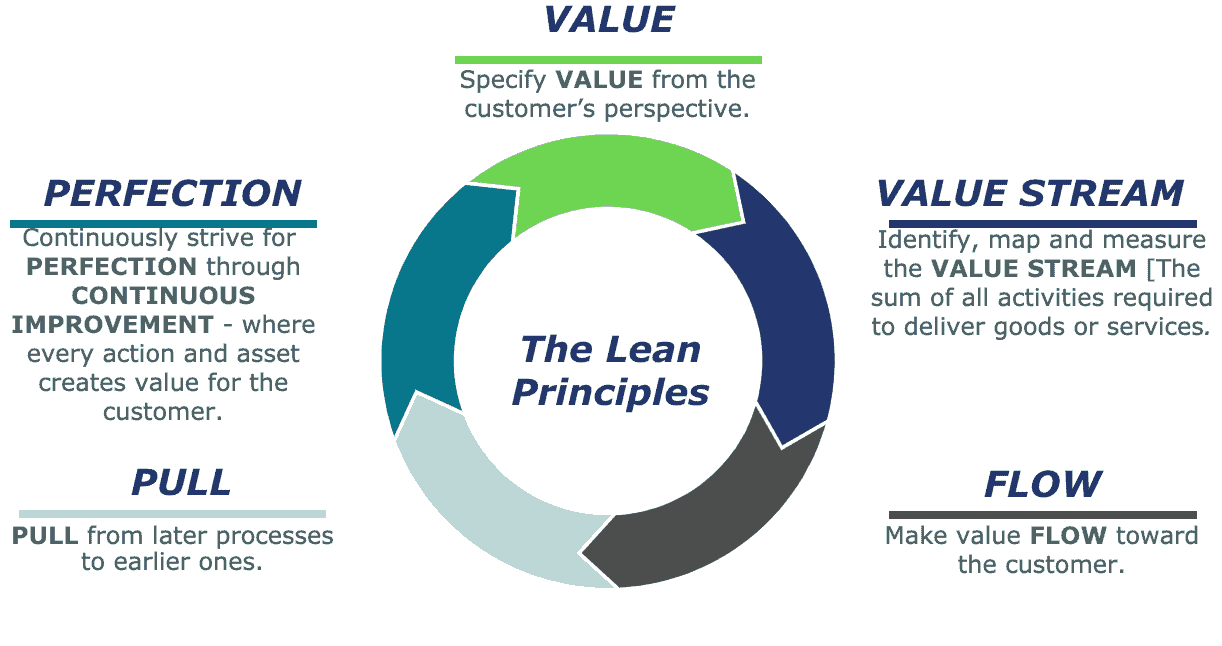Understanding the Five Principles of Lean
The primary principles related to lean originate in manufacturing practices but nowadays are used to innovate in the world of knowledge management. Lean fosters continuous improvement while keeping respect for people at the centre of its ethos. The primary principles of lean originate in the book “The Machine that Changed the World” by Daniel Roos, James P. Womak, and Daniel T. Jones. Below we will discuss the five principles at the centre of lean that are used to improve efficiency in the workplace and in workplace processes. The overview of each of these principles will provide an analysis of how to implement lean in your own organisation.
- Identify Value
Identifying the value that your product or workplace has for consumers can help you to define the parts of your business that need attention. Value refers to anything that consumers are willing to pay money for. Having an accurate picture of the wants and needs of your customers is paramount. This will help you to know how to communicate effectively with them. Oftentimes customers are not sure exactly what they want, especially in relation to new products or industries. Interviews, gathering demographic information, web analytics and surveys are effective ways of asking your customers what they think of your service, and more importantly what they find most valuable about your business. Identifying the price they are willing to pay and the ideal way that they want to receive that product or service will allow you to critically assess your current methods of delivery. Identifying the value of your business is about envisioning your ideal end goal and pursuing it. - Map the Value System
Once you have identified the value or goal of your business, you should begin to map the value system. The value system is any step involved between gathering the raw materials and the final product being in the consumer’s possession. Mapping out your value system can be an unexpectedly helpful experience. You may think you understand all the steps involved in your current delivery system but by examining each action you will see that there are almost always steps that can be eliminated.
The value system can include processes from production, design, procurement, human resources, delivery, or customer services. Use a single page to map the flow of the product through each process so that you can see how each action connects to another. The goal of this activity is to remove any step that does not add value to the system. An added benefit to this activity is a deeper understanding of your business operations more generally. - Create Flow
Once you have removed the wasteful steps from your value system, you should examine the remaining steps for maximum efficiency. Investigate any steps that involve frequent delays, interruptions, or bottlenecks. This is in order to maximise flow between steps. If the valuable steps are in a fluid sequence, the product should flow towards your desired goal more smoothly. Creating multifunctional departments can be a helpful strategy for maximising flow. As well as this, employing interdisciplinary people who are able to adapt to a number of situations will aid in creating flow. This process should lead to improved productivity and efficiency across the board. - Establish Pull
A pull-based system is based on products being manufactured when they are needed, in the quantities they are needed in, and allows for just-in-time delivery. This system is desirable as inventory is considered as one of the most wasteful activities in production systems. The pull-based system will reduce inventory and work-in-progress items, while maintaining the necessary materials and information to aid flow in your value system.
Pull-based systems are a core facet of lean principles because they are motivated by the needs of the consumer. Retracing the value system from the end to the beginning ensures that the products being produced are meeting the exact needs of consumers. - Seek Perfection
The final step of the lean principles should be integrated at every step of the process. Each member of your staff should be encouraged to seek perfection as they deliver services and products to meet the needs of the consumer. This is what makes lean principles a continuous process of innovation and improvement. By using the first four steps to reduce waste, you are already employing the fifth principle, helping your business to get closer to perfection everyday.
Conclusion
The most important part of implementing the lean principles is to set a clear goal. Once you have identified the main value you can offer customers, you can set about pursuing perfection. It is also important to explain the importance of the lean principles to your entire staff. Having a whole team of people working to eliminate waste will make the process easier. The main objective of the lean principles are to deliver elite customer value by removing waste and empowering employees to seek continuous improvement



